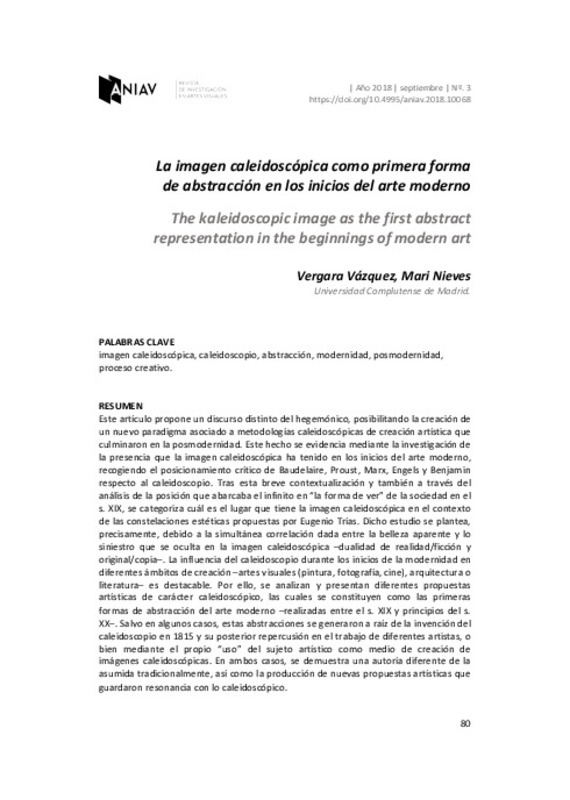|
Resumen:
|
[EN] This paper proposes a different discourse from the predominant one, allowing the creation of a new paradigm associated with kaleidoscopic methodologies of artistic creation that culminated in postmodernity. This fact ...[+]
[EN] This paper proposes a different discourse from the predominant one, allowing the creation of a new paradigm associated with kaleidoscopic methodologies of artistic creation that culminated in postmodernity. This fact is evidenced through the research on the presence that kaleidoscopic image has had in the beginnings of modern art, presenting the critical position of Baudelaire, Proust, Marx, Engels and Benjamin regarding the kaleidoscope. After this brief contextualization and also by analysing the position that the infinite notion had in “the way of seeing” of society in 19th century, the kaleidoscopic image would be categorized into the context of the Eugenio Trías’ aesthetic constellations. This proposal is due to the simultaneous correlation between the apparent beauty and at the same time the sinister side hidden in the kaleidoscopic image –dualities reality/fiction and original/copy–. The kaleidoscope influenced different creation areas –visual arts (painting, photography, film), architecture or literature– during the beginnings of modernity. Therefore, different artistic proposals that have a kaleidoscopic background are analysed and presented as the first abstract representations in modern art –made between 19th century and early 20th century–. Except in some cases, these abstractions were produced thanks to the influence given by the invention of the kaleidoscope in 1815 and its impact in the artworks of different artists. It also happened due to the performance of the artistic subject as medium, mainly in relation to the creation of kaleidoscopic images. In both cases, it is shown an authorship that is different from the traditional one, as well as the production of new artistic proposals that have connections with the kaleidoscopic perspective.
[-]
[ES] Este artículo propone un discurso distinto del hegemónico, posibilitando la creación de un nuevo paradigma asociado a metodologías caleidoscópicas de creación artística que culminaron en la posmodernidad. Este hecho ...[+]
[ES] Este artículo propone un discurso distinto del hegemónico, posibilitando la creación de un nuevo paradigma asociado a metodologías caleidoscópicas de creación artística que culminaron en la posmodernidad. Este hecho se evidencia mediante la investigación de la presencia que la imagen caleidoscópica ha tenido en los inicios del arte moderno, recogiendo el posicionamiento crítico de Baudelaire, Proust, Marx, Engels y Benjamin respecto al caleidoscopio. Tras esta breve contextualización y también a través del análisis de la posición que abarcaba el infinito en “la forma de ver” de la sociedad en el s. XIX, se categoriza cuál es el lugar que tiene la imagen caleidoscópica en el contexto de las constelaciones estéticas propuestas por Eugenio Trías. Dicho estudio se plantea, precisamente, debido a la simultánea correlación dada entre la belleza aparente y lo siniestro que se oculta en la imagen caleidoscópica –dualidad de realidad/ficción y original/copia–. La influencia del caleidoscopio durante los inicios de la modernidad en diferentes ámbitos de creación –artes visuales (pintura, fotografía, cine), arquitectura o literatura– es destacable. Por ello, se analizan y presentan diferentes propuestas artísticas de carácter caleidoscópico, las cuales se constituyen como las primeras formas de abstracción del arte moderno –realizadas entre el s. XIX y principios del s. XX–. Salvo en algunos casos, estas abstracciones se generaron a raíz de la invención del caleidoscopio en 1815 y su posterior repercusión en el trabajo de diferentes artistas, o bien mediante el propio “uso” del sujeto artístico como medio de creación de imágenes caleidoscópicas. En ambos casos, se demuestra una autoría diferente de la asumida tradicionalmente, así como la producción de nuevas propuestas artísticas que guardaron resonancia con lo caleidoscópico.
[-]
|








